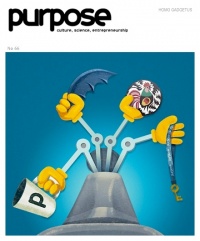
Interview
A short life
What is a gadget for you?
I admit that I do not know a dictionary definition of a gadget. For me it is an item, a product made not to carry out some useful function but to amuse. A gadget, in essence, is unnecessary.
So are there any features that a good gadget should have?
I do not know if gadgets can be good. First gadgets that come to my mind are the products sold on stalls at the fairs. It is a variety of all kinds of items that are short lived and then they are being discarded. Gadgets by assumption have this bad characteristic that after short time they become garbage. Unless they are expensive like those porcelain figurines which are being put in the small display case behind the pane and it is necessary to dust them. I appreciate this function – informing about the social status of the owner or decorative - provided that after throwing it away the item will not encumber the environment and discarding of it will not be associated with remorse.
When I am getting gadgets I put them into a drawer but eventually discard of them anyway. So actually I do not know why I am accepting them. After all, there have been some money and energy spent on them and that makes me feel sad. Of course, there are also useful gadgets like mugs or pens, but, in essence, their tackiness makes them unwelcome. Perhaps I am different than everyone else but I rebel against such items.
Some time ago I was in jury of gadgets competition in one of government institutions and tough selected projects seemed to be useful they have been made as cheap as possible (a tender). Because of that their life will be short and that makes quality matter suspicious. Every client just wants the gadget to be cheap because it enables to promote a company on as large a scale as possible.
In that case, what do you think about an idea of involving young designers and craftsmen that are little known or not known at all into creating advertising gadgets which promote e.g. EU projects?
I would prefer youths to run more useful activities. They can, of course, involve into gadgets designing and surely this is for them an opportunity for interesting project proposals. But I would prefer that their energy was spent on important issues that cry out to heaven and which can and even should be solved in a better way. For example, right now I am sitting at the train station in Poznań looking out of the window and I see people sitting on benches that are aesthetic, functional and executive drama. Public space in Poland is completely neglected, nobody cares about this aspect. We are accustomed to mediocrity of design and manufacturing. Contests and public debate could make a difference. Instead there are more gadgets competitions organized for young people. I wonder why the organizers of competitions are fierce on them. Because it is the easiest and cheapest? Is it because they can be sloppy and there is no need to take responsibility for them?
Do you have similar opinions about gadgets selected for the Polish Presidency in the Council of the European Union?
All that comes to my mind are spinning tops. When the word 'gadget' appeared in media, I have considered the whole matter to be unimportant. A spinning top is a spinning top. Children may play with it for a while, unless it will brake down at the first attempt to use it. I do not know the other proposals. I am against gadgets because I can see too many upsetting matters around me that can be solved by wise designing. Therefore our sensitivity could be focused on issues that bother us. If it has to concern gadgets, they could be more thought out instead of being sloppy and not good for anything except to be thrown out.

How the idea of foam logo was invented?
Dr. Brian Glover was washing the dishes and when he clapped his hands he saw bubbles floating in the air. It was a situation like this when the idea of bubbles floating in the air, shaped like figures, animals, letters, logos and other things, was invented.
Is Flogos foam ecological?
Yes. It is made from biodegradable surfactants, which is the same ingredient which is in the hand soap, but in milder form.
Flogos foam is over three 3 old now. Did you always use it according to your initial idea?
So far, what was the strangest use or logo made of it? The strangest thing was probably the logo shaped like the human body, a murder victim, which was drifting about in the sky during the Comic-Con in San Diego - the biggest trade fair of comedy book and popular art in the World. We also had a customer who ordered Flogos in the shape of an airplane - people thought it was a real aircraft.
Do you have any information about the results of promoting actions in which the Flogos were used?
Yes, our distributors tell us that their customers are satisfied with high turnout at the events where Flogos were used. People come to those events, because they saw the foam in the air and they are curious where did it come from. Other distributors tell us that the customers like to use pictures and films taken during those events, e.g. with children trying to catch the "little clouds". They use these materials on their websites and other promotional materials. We received information that those events were getting better reviews and that sales at places with floating Flogos is greater - from t-shirts to food.


Would you call Flogos™ a gadget?
No, this is a unique and innovative marketing tool that causes a sensation and gathers crowds of observers wherever it appears. Gadgets tend to have a very short life, while Flogos™ for almost 4 years constantly evoke excitement, and we still have not used its full potential in the market. This month, we introduced a new version - Flogos™ Lite - which will increase the number of companies and individuals who use it in various industries, from advertising companies, car dealers, radio stations, to amateur and professional sports teams in private parties and events. You have distributors in more than 10 countries and regions.
Does the interest in Flogos continue to grow?
We have distributors in more than 20 countries and yes, interest in Flogos continues to grow. We are looking for more distributors and dealers who sell the machine that create Flogos. Being a distributor of it is a great way to differentiate oneself from the competition. Flogos™ Lite can be rented as well as purchased, but it pays more when it is purchased.
Why do you think Flogos have gained such a popularity?
Because it is a simple and a very unique idea which attracts attention and arouses the interest. People can stand for hours, watching the shapes floating in the sky. It recalls everyone's childhood memory when we were fascinated by simple, everyday things. Events, during which Flogos are used, also attract more media – television, newspapers and even radio. Is not this a great idea to raise a brand recognizability?
A conversation with Czesława Frejlich, editor in chief of 2+3d magazine and the producer of Flogos, was conducted by Agnieszka Furmańczyk.

Innowacyjny pomysł, wykorzystanie praw fizyki, trochę chemii i biologii wystarczyło, aby stworzyć Flogos. Co to takiego? To jednocześnie biodegradowalne piankowe logo w wybranym kształcie i wytwarzająca je maszyna. Flogosy są wykorzystywane do działań marketingowych zarówno przez największe, jak i mniejsze firmy, a także instytucje i osoby prywatne. Zapraszamy do przeczytania wywiadu z wynalazcami i producentami Flogosów, którzy opowiedzą o idei oraz pochodzeniu swojego pomysłu.
Check the archive

no 66 August 2012
theme of the issue:
Homo Gadgetus
< spis treści
Article
From Editors
Interview
A short life - conversation with Czesława Frejlich, editor in chief of 2+3d magazine and the producer of Flogos - Agnieszka Furmańczyk.
Presentation
Hand Made by POKL
Analysis
Homo gadgetus - Artur Zaguła
Culture Industries
Polish way gadget - conversation with Elżbieta Roeske – Director of Product Group of arena DESIGN and Barbara Vogt – Director of Gift Expo Fair - Piotr Komorowski.
Workshop
A good gadget - Maciej Mazerant





